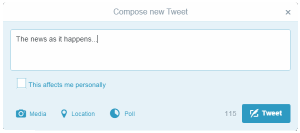I have the following simple idea: a news aggregation tool that pulls news items from Internet sources and applies a fully democratic weighting process. The news items are presented as a time line or a world map.
Problem 1. How can the aggregation tool decide which Internet sources to trust?
I assume, for reasons of simplicity and because the Arab Spring has been called the Twitter revolution for a reason, that the Internet source is twitter dot com. The problem then boils down to the abuse of Twitter accounts. People could in theory create
hundreds of fake Twitter accounts to report, say, violence perpetrated or suffered by a certain ethnic group. This, however, can and will be done by both sides of the conflict, so the effects would cancel out if we can assume their access to technology is equal (which is often not the case, for example in conflicts between an illiterate insurgency and a wealthy state). In order to counteract the proliferation of fake accounts, the news aggregation tool could establish a vouching system, whereby Twitter accounts can vouch for each other by ticking a check box saying “I know this person in real life”. The fake accounts would show up as a distinct cluster that could, once identified, be eliminated. This doesn’t seem to be a big challenge given the complexity of problems in the current Big Data industry.
Problem 2. How can the aggregation tool decide which items to consider news?
People will tweet and retweet the “news” when Katie Perry buys a puppy, so that event will show up as news. However, psychology suggests (see for instance Dan Ariely: “People may allow themselves to cheat sometimes, but not if it involves identifying themselves as Cheaters.”) that people will be honest if given the chance. A simple twitter check box saying “this affects me personally” will likely be answered honestly, because there is no gain in lying here.
What happens is that all of a sudden an earthquake in China, a flood in Pakistan will get the amount of attention decided by the people affected. It will show up as a major news event simply because of the amount of people affected. This might not be considered important news in, say, Alaska, but the whole point is that the subsequent filtering of the news is something that happens in broad view of the public. Everyone who tunes in to the news can compare it to our aggregation tool and see how much it has been distorted to cater for their local group (normally a nation or language group). This kind of transparency fosters the solidarity of a global village. People are brought together when the mechanism designed to keep them focused only on their own artificial community, is made transparent.
Problem 3. How can the aggregation tool achieve democratically fair reporting in the face of unequal distribution of Internet access?
The website opensignal.com shows worldwide mobile phone coverage. in most countries people are connected. Mobile coverage of at least 2G roughly matches population density.
Where people have below-average access to the Internet, such as Central Africa or rural China, such statistics could be overlaid on top of the news map and be counted as an additional weight factor to compensate for the lack of access. A news event reported from With the proper statistical tools, we can get close to “one person, one vote”.
